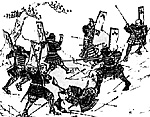 1. Orders and Locations. Being a siege each unit involved on both sides had to have a base - be it house, barrack or tent. The main criteria for this was where the unit would be employed in the battle and I allocated them accordingly.
1. Orders and Locations. Being a siege each unit involved on both sides had to have a base - be it house, barrack or tent. The main criteria for this was where the unit would be employed in the battle and I allocated them accordingly.
a. Defenders. The next step was to allocate areas of responsibility for the defenders and this was done by producing a simple set of Standing Orders cards for each unit, for example:
-
Unit: Mosokito (archers with a blue sashimono).
Base: Inn of the Utmost Delight
Location: South of the Don-jon.
Orders: When enemy attack Crane Gate you are to line the north bank of the river and give support to the monks in the event of the walls being breached. You are not to cross the river. Should the enemy beat the monks you are to cover their withdrawal into the city and then fall back to the Inn and HOLD!
Once given, unit orders can only be changed by the personal appearance of the General, who must have been able to observe the situation he is reacting to or has been told by a messenger. I have no time for commanders who can instantly control units when something unforeseen occurs. I like to think out what could happen, give unit orders accordingly and then my figure on the table spends most of my games galloping around (on Pegasus it seems) trying to sort out the chaos my "plans" have caused. Fun.
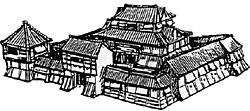 b. Attackers. For the attackers I did not have to be so precise about their base and it was simply worked on the principle that the samurai lived in the fort, the ashigaru lived in the cavalry fort, and the ronin lived in their own camp. The "volunteer" peasants were quartered, under guard with the ashigaru and horses. No paperwork required. For their orders I also attempted to do away with excess paperwork for the units that were attacking the Crane Gate and its surrounds. I positioned the units in the best possible way and in the formation they would need for their tasks. Then rather than write "The Green Dragon Regiment will advance in column carrying siege ladders and assault the wall to the west of the Crane Gate.
b. Attackers. For the attackers I did not have to be so precise about their base and it was simply worked on the principle that the samurai lived in the fort, the ashigaru lived in the cavalry fort, and the ronin lived in their own camp. The "volunteer" peasants were quartered, under guard with the ashigaru and horses. No paperwork required. For their orders I also attempted to do away with excess paperwork for the units that were attacking the Crane Gate and its surrounds. I positioned the units in the best possible way and in the formation they would need for their tasks. Then rather than write "The Green Dragon Regiment will advance in column carrying siege ladders and assault the wall to the west of the Crane Gate.
On achieving the first objective they will take and hold the bridge over the river until otherwise ordered". Having put them in column, given them ladders, and positioned them opposite their objective I placed a flag, painted in their unit colours, exactly where I wanted them to assault. Does not look out of place, adds to the colour of the spectacle and works. For the second objective, there does not appear to be any point in giving any specific orders to wargaming units because once combat begins then the rules and the dice take over. The unit would be more likely to storm over the bridge in pursuit of the enemy rather than hold the position! I "plan" accordingly!
RulesAT THE FRONT
With reinforcements obtained by both sides the warfare between Toranaga and Ishido continued from that described in LW 108 p37. Ishido had withdrawn into the city and was ensconced behind the high walls (described in Lone Warrior 105) and under cover of darkness the monk Tajima and his men fired the peasants' village and made good their escape back into the city. The village was razed to the ground.
Toranaga completely surrounded the city and sealed it off from outside assistance. He decided to launch his assaults from the south. This entailed storming the Crane Gate and also attacking the Lake Gate, so preparations were made accordingly. Barriers were erected, camps fortified, siege towers, ladders, rams were constructed and supplies brought in. These activities did not go unnoticed and on a moonless night a party of volunteers from the city stole out the Lake Gate and burnt the wooden part of the causeway, without loss. Toranaga now had to change his plans in the area of the lake somewhat and he decided to build a pontoon bridge to the causeway and at the same time to make an assault bridge out of fascines to run parallel with the pontoon.
In the city the defenders had not been idle. Each unit had been allocated an area of responsibility and were positioned accordingly. The city was divided into four separate parts;
1. Crane gate, which comprised of the river controlled by the flood gates and the main bridge from the south into the central part of the city. Guarded by the warrior monks of the Onjo-Ji, who were eager to improve their performance from the first battle.
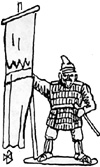 2. City Centre. Located here was the Don Jon (which contained the Treasury), the cavalry barracks, the main infantry barracks, houses of the nobles and the rich merchants. The layout of the city had been designed in accordance with the accepted rules of the time. These presented a formidable amount of narrow streets with barred windows on either side and only the occasional heavily barred gate to break the constant monotony of the walls. These streets formed a bewildering maze to the uninformed and they only allowed a small amount of troops to pass at a time. This was the most heavily defended part of Osaka and also the wealthiest! The largest concentration of troops where in and around the Square of the Golden Bear.
2. City Centre. Located here was the Don Jon (which contained the Treasury), the cavalry barracks, the main infantry barracks, houses of the nobles and the rich merchants. The layout of the city had been designed in accordance with the accepted rules of the time. These presented a formidable amount of narrow streets with barred windows on either side and only the occasional heavily barred gate to break the constant monotony of the walls. These streets formed a bewildering maze to the uninformed and they only allowed a small amount of troops to pass at a time. This was the most heavily defended part of Osaka and also the wealthiest! The largest concentration of troops where in and around the Square of the Golden Bear.
3. Lake Gate At the South of the gate was the lake and partly destroyed causeway. Immediately behind the gate and to the north was the temple area of the city secure behind an earthen rampart topped with stone and logs. The victorious and highly confident monks of the KoFuKu-Ji occupied the gate and walls.
4. Peasant (Eta) Town The road led from the temples to the Eta Town which was defended by a high earthen bank around which ran a walkway and this was topped with a palisade. Protectors were the Eta armed with improvised weapons and a unit of ronin who had been caught in the city by the siege.
Toranaga's Siege Lines Toranaga's men having built their siege lines also constructed a large fort with ditches, earthen walls, stout palisade and two levels of walkway along with wooden towers. A less impressive construction served the cavalry mounts and their guards but they were still in more luxurious surroundings than the ronin who had joined Toranaga with the hope of gaining glory and full time employment with the great man. Units were positioned opposite their objectives and finally the assault was ready to begin.
In the City Ishido ordered his mounted samurai to move to the Crane Gate and from there to launch a whirlwind attack on the congregating enemy foot soldiers. The monks holding the length of the city walls by the Crane Gate watched the slowly approaching enemy with eager anticipation. At the Lake Gate an assault force was assembled to attack and wreck both the pontoon bridge and the ballista. Poorly aimed incendiary missiles had destroyed most of the temples with their overshooting; only two of these projectiles had actually hit the walls and they had been quickly extinguished. There was confidence in the strength of their fortifications and their martial skills amongst Osaka's protectors.
LEGEND
| CITY | |
|---|---|
| Building | Owner/Occupier |
| 1 | General Ikina + Mounted Samurai |
| 2 | General Tajima & KoFuKu-Ji Monks |
| 3 | Lord Mosokito - Archers (Inn - 5 Star) |
| 4 | Partly ruined building - Ninja? |
| 5 | Lord Hara - Arqubusiers |
| 6 | Ronin |
| 7 | Merchant - Goldsmith |
| 8 | Merchant - Caravans |
| 9 | Merchant - Armourer |
| 10 | City Guard & Prison |
| 11 | Merchant - Rice |
| 12 | Inn of Lasting Joy (3 Star) |
| . | Market Place, by statue of the Golden Bear |
| ETA TOWN | |
|---|---|
| Building | Owner/Occupier |
| A | Labourers quarters & Slums |
| B | Red Light District |
| C | Tradesmens quarters |
| D | Guild |
| E | Headman |
| Inn | The Weeping Willow (2 Star) |
Attack across the Lake
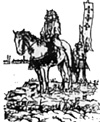 In the early hours of the morning the first pontoon had been poled into position and secured. A bridge was then thrown across from the home bank and also made fast. With the first part of the bridging operation complete the troops prepared themselves for the second and more dangerous part because they would have to bridge the gap between the pontoon and the stone causeway well within range of the defenders' arrows. Speed would be essential. The pontoon was manned, the bridge was moved forward on three sets of large wheels, to the edge of the first pontoon and the assault troops stood ready behind the sweating peasants who were acting as reluctant pioneers. To the west of the pontoon bridge more peasants had been and were busy moving bundles of rice stalks, banded to make fascines, along the ever growing walkway which progressed towards the low walls of the lake side. Overhead missiles were hurled into the city but the aim of the artillery men was disastrous, but soon improved once Toranaga ordered the senior samurai in charge to commit seppuku (probably better known as Hari Kari). Talk about incentives to work well!
In the early hours of the morning the first pontoon had been poled into position and secured. A bridge was then thrown across from the home bank and also made fast. With the first part of the bridging operation complete the troops prepared themselves for the second and more dangerous part because they would have to bridge the gap between the pontoon and the stone causeway well within range of the defenders' arrows. Speed would be essential. The pontoon was manned, the bridge was moved forward on three sets of large wheels, to the edge of the first pontoon and the assault troops stood ready behind the sweating peasants who were acting as reluctant pioneers. To the west of the pontoon bridge more peasants had been and were busy moving bundles of rice stalks, banded to make fascines, along the ever growing walkway which progressed towards the low walls of the lake side. Overhead missiles were hurled into the city but the aim of the artillery men was disastrous, but soon improved once Toranaga ordered the senior samurai in charge to commit seppuku (probably better known as Hari Kari). Talk about incentives to work well!
Storming of the Crane Gate
The cream of the attacking forces had been allocated the formidable task of taking the Crane Gate and its adjacent walls. No peasants would be allowed into this attack and samurai nearly came to blows in order to be allowed to work on the ram that would smash the gates! The troops deployed and they were very crammed in the plain and at the form up points by the bridges. The Daimyo, War Lord, had ordered all his mounted troops to be ready and held in reserve well to the rear of the assault units.
The stage was set and all the players were in position.
Although I am using Samurai in this siege, I found the details and ideas contained in Godfrey Bailey's BG&RP #14 in Lone Warrior 109 (European edition) have added to the overall scenario and I would be surprised if I'm not the only one who takes from one period and uses it successfully in others. Next issue - The well planned progression of the Siege of Osaka.
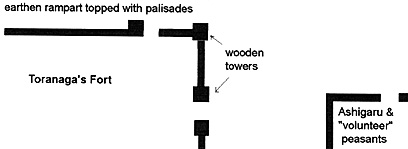
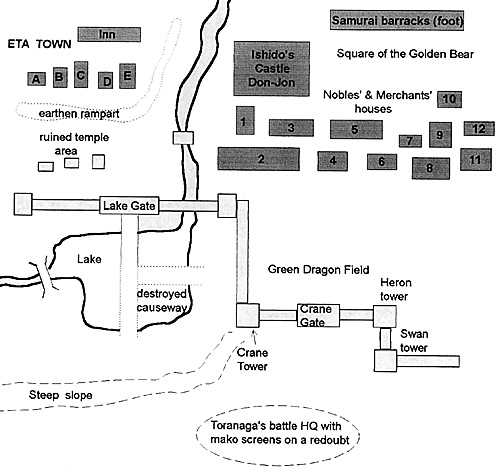
More Feudal Japan
Related
Back to Table of Contents -- Lone Warrior #110
Back to Lone Warrior List of Issues
Back to MagWeb Magazine List
© Copyright 1995 by Solo Wargamers Association.
This article appears in MagWeb (Magazine Web) on the Internet World Wide Web.
Other military history articles and gaming articles are available at http://www.magweb.com
